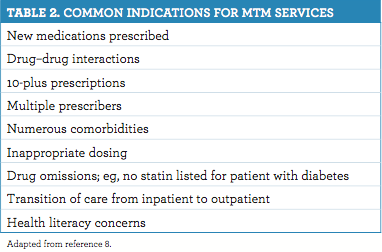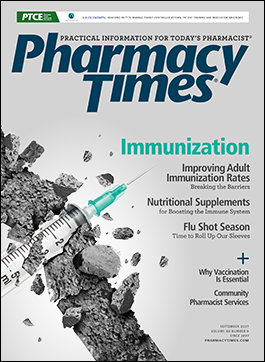Publication
Article
Pharmacy Times
Community Pharmacist Services: The Missing Link to Optimizing Medication Adherence
Author(s):
Failure to follow through on prescribed drug regimens is a common—and costly—problem: Of the 32 million adult Americans who take 3 or more medications daily, 75% are nonadherent.
Failure to follow through on prescribed drug regimens is a common—and costly—problem: Of the 32 million adult Americans who take 3 or more medications daily, 75% are nonadherent. Nonadherence accounts for up to 70% of all medication-related hospital visits and $100 billion annually, excluding the loss of productivity costs.1
Lack of adherence often results from polypharmacy, fear of adverse effects, misunderstanding the importance of the medication, lack of symptoms, or confusion about treatment duration.2 Fortunately, some patient services exist to successfully reduce these barriers.
REDUCING PILL BURDEN
Polypharmacy is defined as taking multiple medications concurrently to treat 1 or more conditions. Some experts describe it as a certain number of prescriptions (eg, 5 or more), but most agree that it is better defined as the presence of medications that are unnecessary or lacking indications.3 Many patients find multiple medications difficult to manage, leading to missed doses.
Vincent Bucchieri, PharmD, of New Haven Pharmacy, in Connecticut, offers pre-poured, individualized blister cards or pill boxes. Each pack contains a 1-month supply of a single medication. The numbered packs hold 1 pill per blister, and patients punch the foil to obtain their daily dose. If patients can’t remember whether they took their medication, punctured foil confirms that they did. Patients can also see clearly when it is time for a refill, rather than guessing how many pills remain at the bottom of traditional vials. This encourages timely refills and decreases the chance of delays related to stock outages.
Blister cards can be bulky and difficult to coordinate for patients taking 10 or more medications. For them, pill boxes containing 4 compartments (morning, noon, evening, and night) for each day are more convenient. Pharmacists organize specific patients’ medications into the boxes. If new drugs are added midmonth, patients bring their pill boxes to the pharmacy for adjustments.
“New Haven Pharmacy offers these services free of charge,” Bucchieri says. “It takes some extra time and money for the materials and packaging process, but it helps patients remember to take their medications. We see patients more regularly for refills, and many report they come here solely for the benefits of these services.”
MEDICATION SYNCHRONIZATION
Many community pharmacies are exploring medication synchronization as another option to improve adherence. This strategy aims to coordinate a patient’s refills so that all fall on the same day every month. Many retail pharmacies are implementing systems that identify patients who have uncoordinated refill dates. The system calculates short-term or partial fills for prescriptions that are out of sync; later, the patient refills all the prescriptions together. This process can be repeated when new medications are added to the regimen (table 14).

The first month of the syncing process can be complicated because many patients require varying, random quantities to reach the refill date. However, once the refills are linked, patients will visit the pharmacy just once monthly. Patients can view and manage synchronization information online and adjust pickup dates or medications. This convenience minimizes adherence barriers such as lack of mobility or transportation.5
MEDICATION THERAPY MANAGEMENT
Our health care system, though improving, still lacks ideal communication among all health care professionals. Many patients see several different doctors for multiple conditions, and those doctors sometimes unknowingly prescribe drugs that interact with others or have the same indications. These inadvertent errors are easily missed and contribute to adverse effects, hospitalizations, and unnecessary costs.6
The pharmacy is the last verification step before medications reach patients’ homes. Many pharmacies are implementing services to identify and resolve polypharmacy complications. One widespread example is medication therapy management (MTM), a pharmacist-driven approach to improving patient outcomes by optimizing medication lists and patient understanding.7
MTM software and documentation vary from pharmacy to pharmacy, though the process is usually similar. Edward Schreiner, RPh, of Stoll’s Pharmacy in Waterbury, Connecticut, uses a program called Mirixa. The system chooses 2 or 3 patients who would benefit from MTM services (table 28) and are eligible for the service based on their Medicare 5-star rating each week. Once a patient has been flagged, Mirixa prompts the pharmacist to schedule an interview to review medications and medical status. The pharmacist creates a comprehensive list of medications that the patient takes and addresses questions, concerns, and knowledge gaps. After gathering information, the pharmacist assesses the case and documents recommendations and counseling points.

“The best part of the program is that it prompts the pharmacist to send a copy of this documentation home, minus the medical jargon, for the patient,” Schreiner says. “It also faxes a detailed copy of our recommendations to the patient’s doctor.” MTM services eliminate more adherence barriers.
Pharmacists can identify appropriate patients for MTM in other ways. For example, Lisa Bragaw, PharmD, at Simply Pharmacy in Waterford, Connecticut, identifies patients’ comorbidities as prerequisites for MTM services. “We search for conditions such as prediabetes and emphasize lifestyle modifications along with our medication consultations,” she says. “Our Facebook page recommends healthy recipes and simple exercise routines for patients.” A local hospital also refers patients with prediabetes who are unwilling to take medications for consults with Simply Pharmacy. By flagging patients for motivational interviewing before they’ve advanced to chronic illnesses, pharmacists may slow progression and reduce medication burden. Pharmacists report that the documentation and MTM process can be time-consuming, but most programs coordinate with Medicare to reimburse for the effort.9
CONCLUSION
Even with complete, transparent access to medical records, it is difficult to discern what medications patients are taking or anticipate their questions and concerns. Community pharmacists’ unique expertise, accessibility, and resources allow them to comprehensively assess and manage medication appropriateness, improving adherence and outcomes. If more pharmacies offered these patient services, they might make a meaningful impact on the $100 billion spent on medication nonadherence annually.10
Ms. Haskins is a 2018 PharmD candidate at the University of Connecticut.
References
1. Iuga A, McGuire MJ. Adherence and health care costs. Risk Manag Healthc Policy. 2014;7:35-44. doi: 10.2147/RMHP.S19801.
2. Wolinsky FD, Hall SF, Edmonds SW, et al. Patient-reported reasons for nonadherence to recommended osteoporosis pharmacotherapy. J Am Pharm Assoc. 2017;57(4):503-509. doi: 10.1016/j.japh.2017.05.003.
3. Bushardt RL, Massey EB, Simpson TW, Ariail JC, Simpson KN. Polypharmacy: misleading, but manageable. Clin Interv Aging. 2008;3(2):383-389.
4. Krumme AA, Isaman DL, Stolpe SF, et al. Prevalence, effectiveness, and characteristics of pharmacy-based medication synchronization programs. Am J Manag Care. 2016;22(3):179-186.
5. Doshi, JA, Lim R, Li P, et al. A synchronized prescription refill program improved medication adherence. Health Aff. 2016;35(8):1504-12. doi: 10.1377/hlthaff.2015.1456.
6. Ponte ML, Wachs L, Wachs A, Serra HA. Prescribing cascade. A proposed new way to evaluate it. Medicina (B Aires). 2017;77(1):13-16.
7. American Pharmacists Association, National Association of Chain Drug Stores Foundation. Medication therapy management in pharmacy practice: core elements of an MTM service model (version 2.0). J Am Pharm Assoc. 2008;48(3):341-353. doi: 10.1331/JAPhA.2008.08514.
8. Ramalho de Oliveira D, Brummel AR, Miller DB. Medication therapy management: 10 years of experience in a large integrated health care system. J Manag Care Pharm. 2010;16(3):185-195. doi: 10.18553/jmcp.2010.16.3.185.
9. Bodenheimer T, Fernandez A. High and rising health care costs. Part 4: Can costs be controlled while preserving quality? Ann Intern Med. 2005;143(1):26-31.
10. Kymes SM, Pierce RL, Girdish C, Matlin OS, Brennan T, Shrank WH. Association among change in medical costs, level of comorbidity, and change in adherence behavior. Am J Manag Care. 2016;22(8):e295-301.







